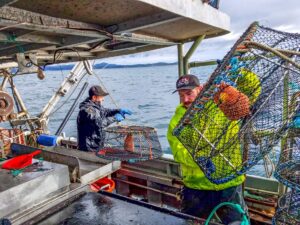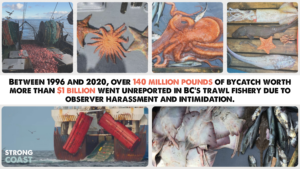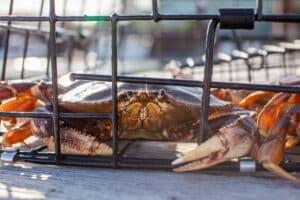Killer whales off the BC coast have been observed doing something astonishing: offering food to humans. The behaviour is rare, potentially unprecedented among wild apex predators, and documented in a new peer-reviewed study published in the Journal of Comparative Psychology.
The study’s lead author, marine researcher Jared Towers of Bay Cetology, was present for two encounters. These incidents involved Bigg’s killer whales, also known as transient orcas.
Elaborating on the significance of this behaviour, Towers said, “We have a long history of interacting with other animals, trying to feed them and gauging their responses. But it’s very rare for any wild predator to do the same to us. This is really the first report of any kind in the literature documenting these cases for killer whales.”
The First Encounters
Towers, based in Alert Bay, BC, first witnessed this behaviour in 2015 while conducting research off northeastern Vancouver Island. A Bigg’s killer whale surfaced near his vessel and opened its mouth, gently releasing a dead ancient murrelet next to the boat.
“It left us a bit awestruck,” Towers said. “I started to think about these animals a bit differently at that point.”
Then in 2018, a second, even more striking encounter occurred. Towers and his team were stationary in their vessel when another Bigg’s orca reappeared near the boat, carrying a freshly killed seal.
“She could have dropped it off the stern or the bow, but she dropped it right in the middle of the vessel, right next to us,” Towers recounted. “We just sat there watching this thing sink down into the water for about 10 or 15 seconds until she did a bit of a circle and came back and picked it up.”
A Global Pattern?
These rare experiences prompted Towers and his colleagues to search for similar events. Their resulting study analyzed 34 documented instances of apparent prey offering by killer whales to humans between 2004 and 2024. The incidents involved orca populations from not only BC and Alaska, but also New Zealand, central Argentina, Norway, California, and the Eastern Tropical Pacific.
To be included in the study, interactions had to meet strict criteria. The whales must have approached humans directly, and there must have been no close approach by the humans (within 50 metres) in the five minutes before the interaction. This ensured the behaviour was initiated by the whales themselves.
“These weren’t mistakes. They weren’t like the killer whales accidentally dropped the food. They wanted to see how people responded,” Towers said.
In 33 out of the 34 cases, the orcas paused after releasing the prey, seemingly waiting for a human reaction before either retrieving or abandoning the prey.
Why Would Killer Whales Do This?
The study explores several plausible explanations for the orcas’ behaviour. Among Bigg’s killer whales, sharing food among pod members is well-documented and foundational to their social structure. Extending that behaviour to humans could represent exploratory or culturally motivated actions.
“I think these cases may really be pro-social representations of conscious learning where these whales are going out of their way to actually try and understand … who we are and how we might interact with them in their environment,” said Towers.
The researchers acknowledged that the behaviour could serve intellectual or emotional purposes for the whales. The killer whales might be experimenting socially, testing the limits of interspecies interaction. The study also considered play as a possible motive, noting that 38% of the cases involved prey manipulation behaviours sometimes associated with play. But it concluded that play was unlikely to be the sole explanation.
“Play often occurs after whales have met their nutritional needs,” the study notes. “But in the cases of prey sharing with humans, the offerings were whole in about half of the encounters.”
Additionally, the whales often recovered the prey after it was not accepted and went on to share it with other orcas. Most interactions lasted under 30 seconds, unlike the more extended play bouts typically observed among orcas.
Advanced Cognition on Display: BC’s Killer Whale Behavioural Diversity
Killer whales are already considered among the most intelligent non-human animals, with highly developed vocal dialects, matriarchal social structures, and group-specific hunting techniques passed down across generations. This apparent food offering behaviour adds to a growing body of evidence suggesting killer whales may be capable of complex social cognition and experimentation.
Southern Resident orcas, which are critically endangered, are famous for their unique vocal traditions, passed down matrilineally, and for their deeply bonded family groups that rarely separate. One of the most noteworthy behaviours observed is their apparent expression of grief: mothers have been seen carrying their dead calves for days, even weeks, in what researchers interpret as mourning.
Orcas have been documented engaging in complex play, including kelp-grooming rituals and synchronized swimming. These behaviours, while sometimes playful, also point to a deeper cognitive world.
Do Not Interact
While the study sheds light on a possible new chapter in interspecies interaction, the researchers stress that these events are not invitations for engagement. Towers urges the public to resist the temptation to feed or accept food from killer whales.
Close human-orca interactions can lead to injury, disease transmission, and behavioural changes that endanger the animals. Feeding, petting, or attempting to reciprocate such behaviour could undermine years of conservation work and erode the natural boundaries necessary for both human and orca safety.
“The researchers strongly discourage people from accepting any prey offered by orcas, due to the potential for both species to harm one another,” Towers notes.




